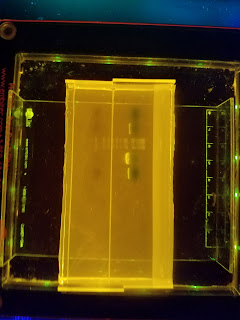Week 8
Hey, everyone! This week, I got to utilize some interesting software in addition to the biotechnology in the lab.
I spent Monday finishing up the FastCloning protocol for two final DNA sequences and sending them to the sequencing lab. In addition, I re-measured the concentrations of the DNA I had been trying to convert to RNA (using a spectrophotometer)-- it turns out my initial measurements had been way off, which might have been causing the issue.
I also learned how to use a DNA chromatograph viewer called Chromas, which is how we manually "fill in" any bases that the sequencing machine fails to recognize.
I spent Monday finishing up the FastCloning protocol for two final DNA sequences and sending them to the sequencing lab. In addition, I re-measured the concentrations of the DNA I had been trying to convert to RNA (using a spectrophotometer)-- it turns out my initial measurements had been way off, which might have been causing the issue.
I also learned how to use a DNA chromatograph viewer called Chromas, which is how we manually "fill in" any bases that the sequencing machine fails to recognize.
| The various peaks indicate different bases, or "letters" of DNA
On Tuesday, I reran the now accurately measured DNA samples through the PCR machine and found success when I ran a gel afterwards.
Unfortunately, as luck would have it, just one of the samples failed-- the second one from the top, which has two distinct bands instead of one.
Finally, Dr. Chang extracted some more oocytes (interestingly, from the same frog as week 1), as we're very close to injecting them.
That night, he flew out to visit his family, but I could still spend the rest of the week in the lab because a graduate student was present this time.
On Thursday, I ran PCR on that one troublesome sample again using different temperature settings, in hopes that it would work this time. I also had to figure out how to operate the nanoinjector again, as it had been six or seven weeks since I last used it.
On Friday, I checked Thursday's PCR results using a gel and got... nothing. Fantastic. I decided to proceed with the original samples anyways, despite the dual bands. So I prepared them for the actual RNA transcription using a series of chemicals, a centrifuge, and a vacuum dryer (sounds like a sitcom).
I also received the sequencing results from Monday and used software like Oligo Explorer and Clustal Omega to confirm them.
At this point, I'm not actually sure I'll be in the lab long enough to see the final results. Fingers crossed, though!
|



Comments
Post a Comment